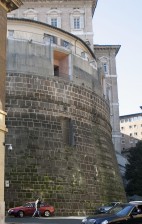World’s ‘most secret bank’: WHAT WENT BEFORE

In this Monday, Feb. 7, 2011 file photo, a building, left, which hosts the Vatican bank, formerly known as the Institute for Religious Operas, IOR, inside the Vatican. A Vatican official has been arrested in a purported plot to bring 20 million euro into Italy from Switzerland aboard an Italian government plane. Silverio Sica, attorney for Monsignor Nunzio Scarano said his client is accused of fraud, corruption and other charges stemming from the plot, which never got off the ground. Sica told The Associated Press that Scarano was a middleman in the operation: Friends had asked Scarano to intervene with a broker, Giovanni Carenzio, to return 20 million euro they had given him to invest. Sica said Scarano persuaded Carenzio to return the money, and an Italian secret service agent, Mario Zito, went to Switzerland to bring it back aboard an Italian government aircraft. He said the plot failed because Carenzio reneged. Carenzio and Zito also were arrested. (AP Photo/Domenico Stinellis, File)
In a letter dated June 24, Pope Francis established a Pontifical Commission to look into the juridical standing and activities of the Institute for Religious Works (IOR), the Vatican’s financial institution.
According to the Holy See press office director, Fr. Federico Lombardi S.J., the commission is tasked with carrying out inquiries and presenting the Pope with a report of their findings “in view of possible reform.”
The commission is composed of five people—Cardinal Raffaele Farina, Cardinal Jean-Louis Pierre Tauran, Bishop Juan Ignacio Arrieta Ochoa de Chinchetru, Msgr. Peter Bryan Wells and Prof. Mary Ann Glendon.
It is not permanent and will be dissolved once it presents its report to the Pope. It is also not involved in the running of the IOR.
Founded in 1942, the IOR or the Vatican bank, is a private financial institution housed in the Vatican City. Its role is to safeguard and administer property intended for religious works and charity. Because so little is known about the bank’s operations and transactions, it has often been called “the most secret bank in the world.”
Article continues after this advertisementA report by ConcordatWatch, a website which keeps track of Vatican treaties, describes the IOR as “built on secrecy.”
Article continues after this advertisement“It keeps accounts, does no audits and claims to destroy records after 10 years,” the report adds.
For years, suspicion has swirled that some of the accounts in the bank had ties to organized crime or political slush funds.
According to a New York Times report, as of 2011, the only time for which figures have been made available, the bank had 20,772 clients—68 percent of them members of the clergy—and $8.2 billion in assets under its management. The bank has said it has around 33,000 accounts.
Inquirer Research
Sources: en.radiovaticana.va, nyt.com, forbes.com, concordatwatch.eu